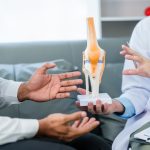- Home
- About Us
- Book Appointment
- Treatments
- Alzheimer’s Disease
- Anti-Aging
- Autism
- Autoimmune Disorders
- Back Pain
- COPD
- Crohns Disease And Ulcerative Colitis
- Erectile dysfunction and Penis enlargement
- Fibromyalgia
- Hip Pain
- Knee Pain
- Lupus
- Lyme Disease
- Multiple Sclerosis
- Muscular dystrophy
- Parkinsons Disease
- Peripheral And Diabetic Neuropathy
- Post Cancer Treatments
- Post Stroke Recovery
- Psoriasis
- Rheumatoid Arthritis
- Shoulder Pain
- Join The Club
- Aesthetics
- Blog
- Contact Us
Joint pain is a common concern worldwide. It affects people’s quality of life and disrupts regular activities.
More than 600 million people suffer from joint pain in the knees, hips, and shoulders.
Joint pain may result from various conditions, including osteoarthritis, rheumatoid arthritis, bursitis, injuries, Vitamin D deficiency, or obesity.
Regardless of the cause, joint pain restricts mobility and inflicts chronic pain. Several medicines, exercises, and even surgeries may help with these conditions.
However, sometimes conventional treatment may not be enough. This is where regenerative therapies with stem cells take over.
It is a cutting-edge treatment that addresses the root cause of the issue and promotes sustainable self-healing.
Advancements in stem cell treatments offer therapeutic solutions. These cells can differentiate, migrate, and transform into different types of cells and tissues.
Let us find out more about stem cells for joint pain treatments.
Overview of Stem Cells
Stem cells are found throughout the body including bone marrow, blood vessels, and skin. The cells work like the natural healing system of the body. Mesenchymal stem cells derived from Wharton’s Jelly are the primitive cells used for regenerative treatments. These cells are anti-inflammatory, immunomodulatory, and regenerative.
Mechanism of Stem Cells for Joint Pain Treatment
Explore the biological process of MSCs to provide joint pain relief –
- MSCS releases bioactive molecules such as interleukin-10 and transforming growth factor-beta to reduce inflammation.
- MSCs can transform into cartilage and bone cells. Also, it may transform into connective tissues to support regeneration.
- Accelerates collagen and proteoglycan synthesis required to restore the joint structure and functions.
- Produces vascular endothelial growth factor, insulin-like growth factor, and platelet-derived growth factor to support the formation of new blood vessels surrounding the affected joint.
- Produces neurotrophic factors to reduce nerve inflammation that causes joint pain.
- Stem cells improve the quality of synovial fluid to lubricate joints and support homeostasis.
- Modulates inflammatory and immune system responses to minimize the formation of fibrotic scars.
Revolutionary Benefits of Stem Cell Therapy for Joint Pain
The timeless benefits of stem cells include –
- Cell differentiation – MSCs transform into required cells when introduced into an area of disease or injury.
- Anti-inflammatory effects – Bioactive molecules and growth factors reduce joint pain and create a suitable microenvironment to support self-healing.
- Stimulate self-repair – Signalling molecules from stem cells stimulate the body’s cell multiplication abilities.
- Promote angiogenesis – Forms new blood vessels to improve blood and oxygen flow into damaged joint areas.
- Modulate the immune system – Modulates the immune system’s actions to reduce inflammation from autoimmune conditions such as rheumatoid arthritis.
- Reduce scar tissues – Promotes natural regeneration of joint cartilage to minimize the formation of scar tissue.
- Targeted repair – Offers targeted joint repair as MSCs migrate to the areas of injury or disease. This means doctors come up with personalized treatments such as stem cell therapy for knee joint pain, hip joint pain, or back pain.
Joint Conditions Addressed with Stem Cell Therapy
Stem cell treatment for joint pain is a promising approach for various conditions. The therapy helps to promote the regenerative and anti-inflammatory actions of the body. This results in pain relief and improved joint functions. Some of the conditions that may benefit from stem cell therapy for joint pain –
Arthritis
Stem cells regenerate cartilage, reduce joint degeneration, and offer sustainable pain relief from osteoarthritis. Also, it modulates the immune system’s actions to reduce autoimmune activities and protect against joint damage from rheumatoid arthritis.
Joint Injuries
MSCs promote tissue regeneration to heal partially torn ligaments or tendons. Moreover, it assists in recovery from ACL tears or rotator cuff damage. Furthermore, it prevents joint deterioration and cartilage damage from repetitive stress.
Chronic Joint Pain
People suffering from aging or degenerative changes experience reduced inflammation and tissue repair after undergoing stem cell therapy.
Degenerative Diseases
Stem cells are effective in treating conditions such as avascular necrosis and joint degeneration holistically. Most importantly, it helps to avoid the requirement for invasive surgical procedures such as joint replacement.
Post-Surgical Recovery
Stem cells are ideal for promoting quick and sustainable healing for people who have gone through joint surgeries.
Bursitis & Tendinitis
MSCs help to heal conditions such as tennis elbow or Achilles tendinitis. Moreover, it alleviates bursae inflammation to restore joint functions.
Facet Joint Syndrome
It is a condition in which the facet joints found in the lower back are negatively affected due to poor posture or degenerative diseases. Stem cells for facet joint pain reduce inflammation, relieve pain, and improve joint functions.
Sacroiliac Joint Pain
This type of condition develops from injuries, arthritis, pregnancy, or inflammatory diseases. Stem cell therapy for SI joint pain is a minimally invasive treatment to restore joint functions and alleviate pain.
[ Read Also: Revolutionizing Relief: Mesenchymal Stem Cells Break the Chains of Chronic Back and Neck Pain ]
Stem Cell Joint Pain Therapy vs. Conventional Joint Pain Treatments
| Differences | Stem Cell Joint Pain Therapy | Joint Replacement Surgery | Medications |
| Method | Stem cell injections are introduced into the targeted area through intravenous, intraarticular, and intramuscular methods. | A surgical procedure to remove damaged joints and replace them with artificial implants.
|
Oral or topical medicines to address the symptoms of joint pain without targeting the underlying cause of the condition. |
| Objective | Stem cell therapy helps to regenerate and repair damaged tissues, cells, and cartilage. | This type of invasive surgery is used to replace irreparable joints. | Topical and oral medicines simply manage the symptoms of joint pain. |
| Invasiveness | Stem cell therapy follows a minimally invasive treatment procedure. | Surgeries are highly invasive procedures.
|
Medicines (oral and topical) are non-invasive. |
| Benefits | Addresses the underlying cause of the condition and promotes self-healing by releasing growth factors and bioactive molecules. These actions reduce pain and inflammation. | The only benefit from this type of treatment is improved joint functions and reduced pain as the original joint is replaced with prosthetics. | The benefits of medicines are minimal as they only relieve the symptoms of joint pain.
|
| Cost | The cost of stem cell therapy depends on multiple factors including patient demographics, severity of joint pain, underlying medical history, number of treatment sessions, and the administration procedure. | Surgeries are expensive as they include doctor fees, hospitalization charges, and post-treatment care expenses.
|
Medicines are usually low-cost compared to the other two treatments as they only provide periodic relief from conditional symptoms.
|
| Side Effects | Rare and negligible side effects including short-term pain and swelling at the site of the injection due to natural recovery. | Surgeries impose high risks of infections, blood clots, implant failures, etc.
|
Side effects from medicines include liver upset and allergic reactions.
|
| Ideal Candidates | People with significant joint damage due to injuries and diseases may recover significantly without invasive surgeries. | Candidates with advanced joint degeneration or failure.
|
Individuals highlight moderate joint pain.
|
Eligibility for Stem Cell Joint Treatments
There are more than 360 different joints present throughout the body. Condyloid, ball and socket, saddle, and hinge are some types of joints found in the body. The joints regulate different types of body movements. Nevertheless, joints are subject to injuries. Therefore, qualified stem cell experts develop next-generation joint treatments based on the severity of the condition. Take a look into the eligibility criteria for stem cell joint pain treatments –
- People with joint cartilage damage from osteoarthritis.
- Candidates noticing joint deformities from rheumatoid arthritis.
- Individuals looking for a holistic non-surgical alternative to joint replacement surgeries for the knees or hips.
- Athletes who want to maintain joint health or recover from ligament, tendon, or cartilage injuries.
- People who did not experience relief from conventional therapies or medicines.
Contraindications of Stem Cell Joint Treatments
People with the following conditions may not be ideal to undergo stem cell therapy. The list of contraindications includes –
- People with systemic or localized joint infections should reconsider this type of treatment until the infection subsides.
- Candidates with severe osteoarthritis or irreversible joint damage may require more than stem cell therapy.
- Individuals with uncontrolled autoimmune conditions such as lupus may experience minimum results from stem cell therapy.
- People under immunosuppressive medications respond faintly to stem cell therapy.
- Individuals with bleeding disorders and taking blood-thinning medicines for hemophilia and thrombocytopenia have an increased risk of bleeding from such treatments.
- Pregnant women.
[ Read Also: Unlock Lasting Vitality – Experience Premier Longevity Treatments in Mexico! ]
Expectations from Stem Cell Treatments
Get a detailed overview of what to expect from joint pain treatment with stem cells –
Treatment Process
Glance through the steps for the stem cell joint pain treatment –
- A one-on-one consultation session to identify the cause and extent of joint pain along with other medical conditions.
- Blood panel tests are conducted to determine the efficiency of stem cell treatments based on the candidate’s condition.
- The doctors prepare a tailored treatment plan according to patient screening results.
- A stem cell therapy session takes around 30-60 minutes.
- Stem cell injections for joint pain are administered through intravenous (IV), intramuscular (IM), or intraarticular (IA) procedures.
- The doctor confirms the number of therapy sessions required for the candidate.
Time To See Visible Treatment Results
Several factors influence the results of stem cell treatments. The extent of joint pain, underlying medical conditions, and lifestyle factors. Get a glimpse into how soon or late individuals may experience improvements after the treatment –
- Mild discomfort and inflammation at the injection site are experienced in the first few days after the treatment.
- A gradual decrease in pain and inflammation nearly after 1 month of the treatment.
- Enhanced mobility of the joints as stem cells release growth factors after 2 months of the treatment.
- Active healing of damaged cartilage, ligaments, and tendons occurs within 3 months after the treatment.
Post-Treatment Care Recommendations
Explore the best joint care procedure after stem cell therapy for enhanced results –
- Reduce physical activities for up to 72 hours after the treatment.
- Use cold compresses but do not directly apply ice for swelling issues.
- Refrain from taking anti-inflammatory medicines.
- Avoid high-impact exercises and sports until approved by the doctor.
- Drink plenty of water to support the recovery of joints after stem cell therapy.
- Maintain body weight through a balanced diet to prevent joint injuries.
- Avoid smoking and drinking alcohol.
- Do not force joint activities or ignore pain signals.
Role of Life Altering in Advanced Stem Cell Therapies
Life Altering is a premier clinic with transformative treatment options to naturally repair joints, alleviate pain, and improve mobility functions. Find out how we meet your anti-aging and longevity goals –
- Utility of innovative tools to safely administer stem cell therapy, red light therapy, and conduct blood panel tests.
- Development of personalized plans to provide targeted rejuvenation for individuals.
- Life Altering is a reputed clinic providing exceptional care and successful treatment results.
- We offer non-surgical and risk-free treatment with medical tourism facilities.
Takeaway
The effects of joint pain after stem cell transplant gradually subside. Stem cell therapy is utilized for different joint conditions of the back, hips, knees, and other parts of the body.
It is a minimally invasive approach to reclaim the natural healing abilities of the body from degenerative joint conditions.
Life Altering is an elite clinic for people who seek regenerative treatments for chronic joint pain.
We design custom longevity treatments to address different types of joint concerns. Our stem cell therapy for hip joint pain is an example of healing patients who have undergone surgery or are looking for preventative care to prevent the progress of degenerative joint conditions.
Consult with our doctors to identify underlying issues and come up with comprehensive treatment plans.
Become a part of the LAT Club to enjoy one-on-one consultation, unlock early access to premium products, and receive priority treatments.
Regain your active lifestyle, improve mobility, and indulge in your favorite activities with the amusing potential of stem cells in joint treatments.


